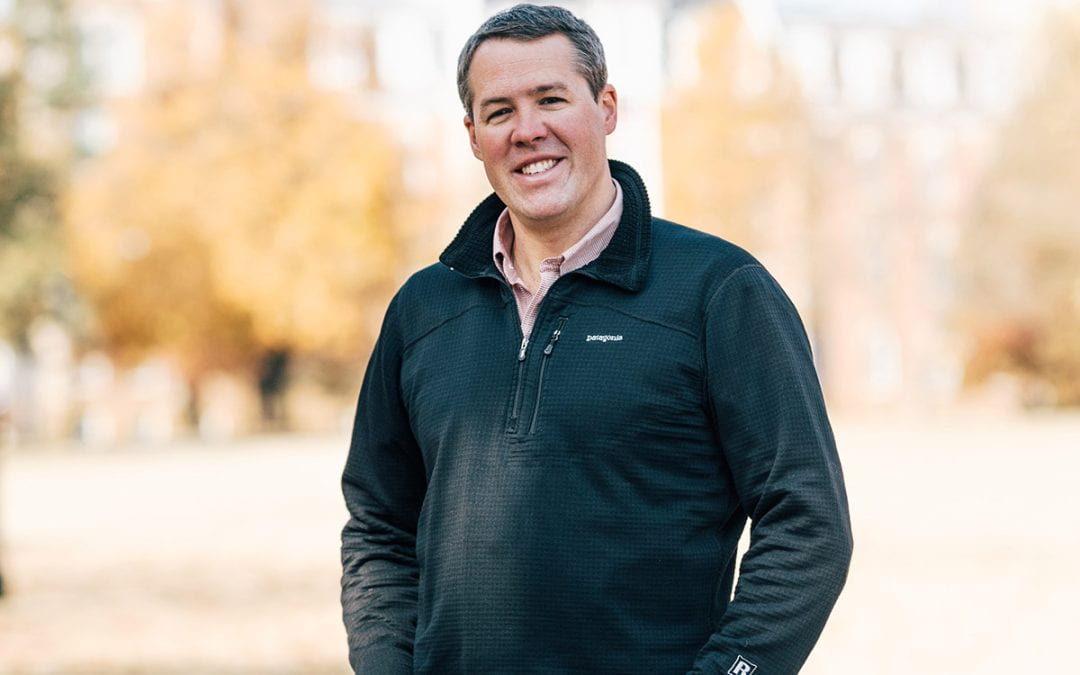Matt Mihalevich (B.L.A. ’01) is the active transportation manager at the City of Fayetteville. In his role, he is responsible for all aspects of the development of the trail system. Mihalevich said he used his design degree to help create Fayetteville’s first paved trails and in the development of Fayetteville’s 54-mile network of shared-use paved trails.
When did you become interested in landscape architecture and why?
I discovered landscape architecture while developing several outdoor spaces at the property where I grew up in Springfield, Missouri. These projects included the design and construction of two separate water features with recirculating cascading streams and ponds. I have always had a fascination with water and drainage.
My college career started at the University of Missouri, where I studied engineering. During the summer after my first year, I was looking for something different and always had landscape architecture in the back of my mind. My mother encouraged me by setting up a meeting with the landscape architecture department head at the U of A at the time — Karen Hanna. I found myself in a welcoming environment with a small class size and the educational experience I was hoping for.
Why did you choose to go to the University of Arkansas and/or the Fay Jones School?
Proximity to my hometown was a primary factor in choosing where I wanted to attend university. Missouri did not offer landscape architecture, so another close option was Kansas State University in Manhattan, Kansas. But the University of Arkansas had a strong landscape architecture program and setting that appealed to me the most. I am grateful for this choice as I was able to thrive during my five years at the University of Arkansas and admired the setting and culture of Fayetteville.
What has been your career path so far?
I spent the summer of 1999 in Cotter, Arkansas, working among a design team and program with the University of Arkansas Community Design Center. Our team worked closely with community stakeholders to provide a detailed redevelopment plan and model for the town. After completing my senior thesis on a greenway trail in Springfield, Missouri, I graduated from the University of Arkansas in the spring of 2001. I had the opportunity to travel through Europe for five weeks before starting my first real professional job with LandPlan Consultants in Tulsa, Oklahoma. During my three years with LandPlan, I gained valuable experience designing and implementing quality paved trails.
In 2004, an opportunity came up to work as a park planner with the City of Fayetteville Parks and Recreation Department, so my wife and I happily moved back to Fayetteville. I worked under the city’s first trail coordinator and was able to help create some of Fayetteville’s first paved trails. After a couple of years, I was promoted to become the trails coordinator and have been instrumental in the development of Fayetteville’s 54-mile network of shared-use paved trails over the past 19 years.
What has been your favorite project to work on?
The most impactful project I have worked on was the Scull Creek Trail in Fayetteville. Mandated by the public and city leadership, this was Fayetteville’s first truly connected trail, the “backbone” extending north-south through the heart of the city. Completed in 2008, this trail proved that “if you build it, they will come,” as it has been heavily used for both recreation and alternative transportation options for the community. This trail is now part of the 40-mile Razorback Regional Greenway connecting Northwest Arkansas.
What is the most challenging part of your job?
The most challenging part of creating a trail network is the sensitive work of acquiring the property necessary for the trail. This can be challenging and involves working closely with property owners to understand their needs and create the best situation for the owner and the community.
How did your degree in landscape architecture prepare you for your career?
My study of landscape architecture provided me with the skills to navigate the design process from concept to construction details, and the rigorous studio time management has served me well throughout my career. This background has also provided a site-specific perspective to trail design with a focus beyond the standard design practices to a higher level of environmental sensitivity and aesthetics.
What are your interests or involvements outside of design?
I have enjoyed remodeling and restoring our historic home on Lafayette Street, including hand-digging a basement under the house. I also enjoy a variety of outdoor activities, and I am currently hiking the entire 164-mile Ozark Highlands Trail, section by section.
Who have been your biggest supporters?
My wife, Katie, has encouraged and supported me as my career ambitions have evolved. She has confidence in me, which is a tremendous support. In addition, the citizens and leadership of Fayetteville have continuously supported the trail development program through the approval of funding and bond referendums.
What’s the best part of your career?
Seeing people enjoy and value the paved trails is one of the most satisfying aspects of my job. While in school studying landscape architecture, I found Fayetteville to be an amazing place, and I am grateful for the opportunity to continue to help make Fayetteville an even better place to live, work and play.
